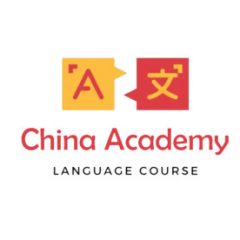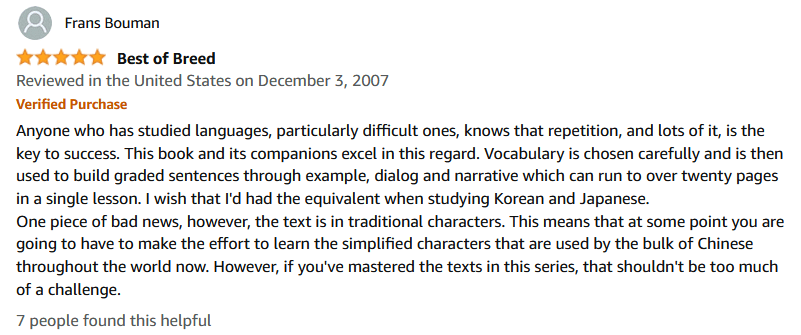If you’re (self-)studying Chinese nowadays, you’ve probably never heard of John DeFrancis’ classic Chinese reader. The Beginning Chinese Reader was first published by Yale University Press in 1966 and still can be purchased today. But is it worth buying and why (not)?
What to expect?
John DeFrancis‘ “Beginning Chinese Reader” is a heavyweight. The over 400 pages thick work contains 5 units, consisting of 30 lessons in total. It introduces 400 (traditional) characters in 1200 combinations, more or less matching HSK 4 – and that’s merely part 1. Characters are introduced in large size, and tables indicate the sequence of strokes used in their formation (tables and lists are included in part 2).
Approach
The key element of DeFrancis’ approach is repetition. He introduces a number of essential characters like 人, 刀, 力, 口, 土, 大, 女, 子, 小, 山, but manages to transition into actual character combinations and sentences pretty quickly. Then you get things like:
中国
中国话
说中国话
会说中国话
也会说中国话
他也会说中国话
And so on. Including the typical dialogues you come across at this stage of learning: “你是哪国人?我是美国人.” But DeFrancis goes beyond that pretty soon though, masterfully combining a small number of characters in ever new variations. Not just for the sake of stringing characters together for reading practice, but sentences, patterns and words you can actually use. Especially as a university student – I should add.
Repetition, repetition
In other words, DeFrancis places a healthy emphasis on combinations rather than individual characters. The key ingredient is reading the same characters over and over again in different contexts and combinations (the book contains “120.000 characters in running text”). A small number of characters are introduced in each lesson. Because they are used in a systematic way, it helps to develop and retain new vocabulary. It’s a bit like sentence mining avant la lettre.
How the author intended the reader to be used
The Beginning Chinese Reader complements another book by DeFrancis called “Beginning Chinese”. The author suggests to study the characters in the reader only after the related material from “Beginning Chinese” has been learned in the transcription form. I understand this as a pinyin-before-hanzi approach, implying you have to be able to speak and understand some basic Chinese. DeFrancis – coming from the pre-internet age – seems to assume that the typical learner is studying Chinese in a classroom situation. But he also mentions this:
In the interest of covering as much ground as possible students should be required to assume the responsibility of reading the material outside of class.
This means self-study. Good to know the reader originally provided recordings which are still available in the Internet Archive, since you can’t learn how to read characters without proper listening material. DeFrancis emphasizes the ultimate goal is reading fluency (not translating). This is to be achieved by “reading, reading, reading”.
For which kind of learner
I already hinted that the the reader was intended for college students majoring in Chinese. I don’t think that really changed a lot. The reader contains many things related to academia: reading and writing books, attending classes, taking exams and teaching. As you advance further in the reader, DeFrancis also introduces aspects of Chinese culture, geography, politics, and everyday life.
What probably changed is that the reader isn’t used in Chinese class anymore. So nowadays I’d view it as a self-study reader to develop fluency in reading traditional characters. I think it can be particularly useful to those who’ve already studied simplified characters, but haven’t been introduced to traditional hanzi.
Focus on traditional characters
When I first bought the book, I wasn’t aware of the fact that this series concentrates primarily on the traditional characters, as all the Chinese study books I had been using so far introduced simplified characters first. After all, simplified characters are most common in today’s world. The second volume includes a special chapter about the differences between simplified and traditional characters. In someway, this traditional-characters-first approach is refreshing, although most learners might prefer to study simplified.
Is it still up-to-date?
This reader focuses on Chinese as it was used before the founding of the PRC. DeFrancis traveled extensively in China back in the 1930’s, so not surprisingly some of the vocabulary and dialogues are outdated. Sentences like “I remember before the People’s Republic . . .” and “That old man was an official in the Qing Dynasty . . .” serve to illustrate that – as a reviewer on Amazon notes.
In terms of methods used for enhancing reading fluency, the reader is not outdated at all. In fact, DeFrancis methods have been very influential in western Chinese language education. They have been adopted and fine-tuned in course books and graded readers for example. However, you’ll have a hard time finding more recent Chinese readers that lay out a path towards reading fluency as thoughtful and efficiently.
Conclusion
Does DeFrancis Chinese reader survive in today’s Chinese learning world? Is it worth ordering a copy online? DeFrancis’ classical reader in my view is still a good choice, if you want to study traditional characters and take the somewhat dated content as an adventure. The author truly knew his subject. That’s why every lesson naturally leads into the next one and vocabulary keeps adding up as systematically as possible. It’s pretty challenging stuff, so having studied simplified characters first and being familiar with the vocabulary used is an advantage.
If you’re not that interested in mastering traditional characters or prefer to read present-day short stories and articles, this book is not for you. The good news is that many later authors adopted DeFrancis’ methods. Take any good Chinese graded reader series for beginners or other study books, for example:
Mandarin Companion Graded Readers (Short stories built around a limited amount of characters)
Selected Abridged Chinese Contemporary Short Stories (Short stories built around a limited amount of characters)
New Practical Chinese Reader (A popular course book series – much newer, yet not entirely up-to-date, focused on reading fluency and writing (simplified) characters.)
There’s but one original though, and that is DeFrancis’ “Beginning Chinese Reader”.




